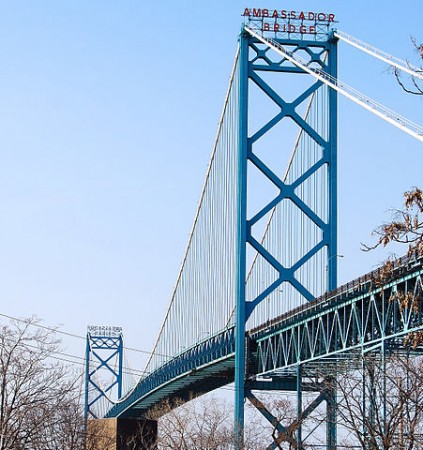
Transport Canada concerned over structural integrity of Ambassador Bridge
by Jordan Press, The Canadian Press

The privately-owned bridge is the busiest commercial trade crossing between the U.S. and Canada, and the ministry doesn't think its owner has done enough to maintain it

The Ambassador Bridge, which connects Detroit, Mich. to Windsor, Ont. The route is one of the most important shipping arteries in the world. PHOTO: Patricia Drury, via Wikimedia Commons
The concerns focused on the long-term health of the concrete deck on the Canadian side of the Ambassador Bridge that supports the roadway thousands of vehicles use annually to carry people and goods between Windsor, Ont. and Detroit, Mich.
The president of the company that owns the bridge said Transport Canada can shoulder blame for decaying concrete over the federal government’s reluctance to let the company build a second span as it pursues construction of its own international bridge along the Detroit River.
“The concern is for the future and that’s why we’re doing the work we’re doing now,” said Dan Stamper, president of the Detroit International Bridge Company.
The Windsor-Detroit crossing is the busiest commercial trade crossing between the U.S. and Canada with almost one quarter of all goods moving between the two countries over the bridge and through the nearby tunnel.
Briefing materials provided to Marc Garneau shortly after he was appointed transport minister show the company that owns the bridge repeatedly promised to carry out work on the concrete deck, but Transport Canada officials repeatedly felt the work didn’t address their concerns.
As recently as June 2014, an outside engineering firm recommended that the concrete deck on the Canadian side of the bridge be completely rehabilitated or replaced. Garneau’s officials detailed what they described as the company’s “unfulfilled commitments to complete repair work,” and concerns about the structural integrity of the deck amid local reports of falling concrete from the bridge last October.
Stamper said workers have replaced concrete, steel, curbs, sidewalks, handrails, and lights so far on about one-quarter of the east side of the Canadian approach. Workers are to soon move to the west side, he said.
The work is taking longer than Transport Canada might like because it is more complicated than similar repairs completed three years ago to the span over the Detroit River, Stamper said.
“There’s a real struggle to do good rehab work and maintain three lanes on the bridge and do it in a fast, efficient, cost-effective way. We are doing as fast, as efficiently as we can, but we did not want to be here,” he said.
The state of the bridge, and just how much work it needs, has been the subject of a long-running battle with political undertones: the American-based owner of the Ambassador Bridge, Manuel “Matty” Moroun, has fought construction of the Gordie Howe international bridge between Windsor and Detroit, for which the federal government is paying.
At the same time, the federal government hasn’t backed Moroun’s proposal to build a second span on the Ambassador Bridge, which Stamper said was key to the company’s repair plans.
“When we apply to build a new bridge in 2004, we said this is a maintenance project. We need to build a new bridge so we can rehab the old bridge and keep the old bridge as a redundant structure,” he said.
There was another black mark in the relationship last weekend when the government ordered the company to install emergency barriers in the interest of public safety. Department officials did a visual inspection last month and didn’t believe the railings would have stopped a car or truck.
The order, known as an emergency direction, is used in cases where federal officials feel their concerns have not been fully addressed by the owner of a bridge or tunnel.
“The safety of the Ambassador Bridge is of critical importance,” Garneau said in a statement.
“Should action not be taken in a timely manner, I will not hesitate to take additional safety measures.”
It shouldn’t be surprising that an 86-year-old bridge is in need of repair.
Older concrete structures tend to crack due to their age. In the case of a concrete deck for a suspension bridge like the Ambassador Bridge, inside the concrete is a steel skeleton that connects to suspension cables.
When the concrete cracks on bridges, salt used to clear roads in the winter makes its way to the reinforcing steel skeleton, known as rebar, and rust builds. The rust takes up more space than the rebar and causes further damage to the concrete, said James Wight, a professor of structural engineering at the University of Michigan.
“As it (the rust) expands, it starts popping pieces of concrete off, or making the cracks larger,” he said.
“It is a deterioration cycle that once that calcium chloride gets to the steel, it starts rusting and that further deteriorates the concrete.”